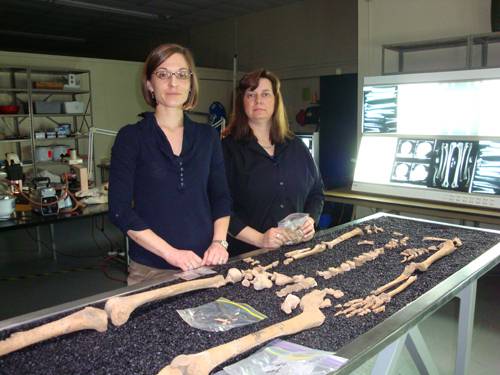Forensic anthropologists solve historical cold cases for National Geographic TV
By Ann Friou
University News Service
March 23, 2012
Forensic anthropologists at Texas State University-San Marcos are helping to solve four unusual cold cases, for the television series “The Decrypters” that will air on the National Geographic Channel beginning March 29 and running through May 10.
“The series will tie the investigative methods used by forensic anthropologists to sweeping events in American history,” said Michelle Hamilton, who with Kate Spradley is studying the skeletons of individuals who died in America some 150-250 years ago.
“By scientifically examining these human skeletons,” Hamilton said, “we shed light on founding events that defined this country.”

Kate Spradley (left) and Michelle Hamilton in for the Forensic Anthropology Center at Texas State
“Drs. Hamilton and Spradley are two of the nation’s foremost forensic anthropologists, and what they tell viewers about the skeletons is very exciting,” said the program’s producer, Michael Douglas.
“National Geographic is interested in focusing on scientific validity,” Spradley added. “So, while the skeletons appear to have compelling stories behind them, viewers will be able to follow us as we use science to see whether those stories work out.”
Each of the skeletons that Hamilton and Spradley are investigating will be featured in an hour-long episode of “The Decrypters.” They include:
- March 29, 7-8 p.m. CT: The Last Mohican (Albany, NY). A male skeleton from the 1750s is exhumed from a British military cemetery inside Fort William Henry in upstate New York. Fort William Henry, in use by the British at the time of the French and Indian War (1754-1763), was also the site of a massacre recorded in James Fenimore Cooper’s novel The Last of the Mohicans. Preliminary analysis of the skeleton indicates that he is well-nourished and doesn’t appear to be a British soldier, who would have shown signs of stress from the ocean crossing and adjustment to a harsh American climate. If the skeleton isn’t British, could he have been a Native American, and if so, why was he working for the British?
- April 19: Body Snatchers (Cincinnati, Ohio). The skeletons of a young man and woman are found together in one coffin. Were the couple, who died in the 1860s, married? Had they fallen victim to the cholera epidemic that swept Cincinnati during the city’s phenomenal population boom? Were they buried together to protect them from roving body snatchers, who were stealing corpses of the recently dead on behalf of medical school students?
- April 26: Gold Rush Murder (Sacramento, Calif.). A male skeleton from the 1840s is unearthed at the historic Sutter’s Fort near Sacramento, the first white trading post in California. Was he a pioneer, arriving in a wagon train from the East, or perhaps a Gold Rush prospector? Was he a Native American hired as a guard by the fort’s owner? Was he a Russian who arrived in California via Alaska? Or could he have been related to the ill-fated Donner party, which passed the winter of 1846-47 in the Sierra Nevada, resorting to cannibalism to stay alive? And did the musket balls found in his coffin kill him? Skeletal analysis answers questions about the man’s origin and sheds light on life at the fort.
- May 10: Cowboy Corpse (Denver, Colo.). The Denver coroner’s office seeks help in identifying the large-boned skeleton of a man who died between 1870 and 1880. Could the big man have been a cowboy, a farmer, or a railway worker? What caused his broken nose, pathological leg, and the diamond-shaped gap in his front teeth? And did the man, whose toe bone shows signs of disease, die of gangrene?
Hamilton and Spradley’s research on the bones has been supplemented with DNA, stable isotopes and radiological testing performed by other experts. Computer-generated facial reconstructions have been done on the skeletons for which there are sufficient remains.
The National Geographic Channel’s film crew taped Hamilton and Spradley in 2011, in the Grady Early Forensic Anthropology Lab at Texas State, as they studied the bones.
Hamilton and Spradley teach in the Anthropology Department and work for the Forensic Anthropology Center at Texas State (FACTS). Texas State oversees the largest forensic anthropology research and training facility in the United States. Research done at the facilities by faculty and graduate students provides new information on the processes of human decomposition, information that assists law enforcement in identifying human bodies and establishing the time and nature of death.
Proceeds from the filming of the National Geographic series will support multiple incoming graduate student scholarships in Forensic Anthropology.